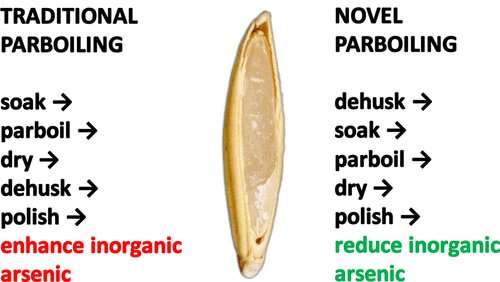Parboiling method reduces inorganic arsenic in rice

Contamination of rice with arsenic is a major problem in some regions of the world with high rice consumption. Now, researchers reporting in the ACS journal Environmental Science & Technology have found a way to reduce inorganic arsenic in rice by modifying processing methods at traditional, small-scale parboiling plants in Bangladesh. The new method has the added benefit of increasing the calcium content of rice, the researchers say.
People in Bangladesh eat about a pound of rice per person per day, according to statistics from the International Rice Research Institute. This consumption is among the highest in the world, placing Bangladeshis at risk for elevated exposure to inorganic arsenic, a toxic substance and carcinogen that can enter rice from the soil of flooded paddies. After harvest, most rice in the country is parboiled, a process that involves soaking the rough rice (with husk intact) in water and then boiling it, followed by other steps to produce polished white rice.
Andrew Meharg from the Institute for Global Food Security, Queen's University Belfast, and colleagues wondered if parboiling wholegrain rice (with the husk removed) would reduce the levels of different forms of arsenic compared with parboiling rough rice. That's because the husk can have high levels of inorganic arsenic, and it could also act as a barrier, preventing arsenic species from leaving the rest of the grain during parboiling.
The researchers tested their new processing method in 13 traditional, small-scale parboiling plants throughout Bangladesh. The team used ion chromatography interfaced with inductively coupled plasma-mass spectrometry to analyze arsenic species in rice. They found that in untreated rough rice, inorganic arsenic is highly elevated in the bran compared with the husk. Parboiling wholegrain rice instead of parboiling rough rice reduced levels of inorganic arsenic by about 25 percent in the final polished grain, while increasing calcium by 213 percent. However, the new method reduced potassium by 40 percent. The researchers say that the potassium loss must be balanced with the advantages of reduced arsenic and increased calcium.
More information: Modifying the Parboiling of Rice to Remove Inorganic Arsenic, While Fortifying with Calcium, Environ. Sci. Technol., Article ASAP, pubs.acs.org/doi/abs/10.1021/acs.est.8b06548
Journal information: Environmental Science & Technology
Provided by American Chemical Society

















